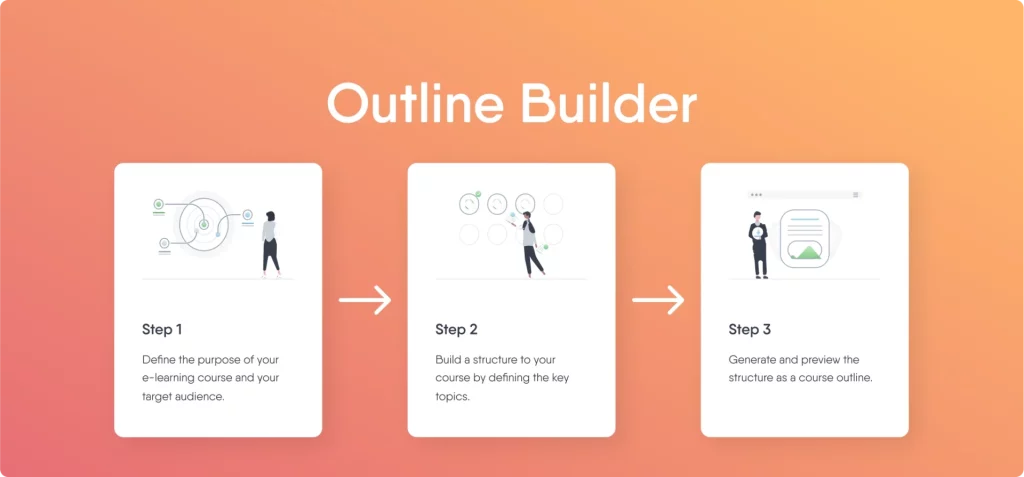Learning Ecosystem: what is it and why do you need one?
Every organization aims to strengthen its competitive advantage. When it comes to your corporate learning strategy, this goal matters too. This is where a carefully planned learning ecosystem comes in. By the end of this article, you’ll know what a learning ecosystem is, what elements you’ll need to build one, and how your organization stands to benefit.

What is a learning ecosystem?
Just like an ecosystem is made up of different plant and animal species interacting with each other to form an environmental system, a learning ecosystem consists of different groups of people and tools that work together to facilitate corporate learning. But why do you need a learning ecosystem?
Every organization strives to maintain or enhance its competitive advantage, which is primarily achieved by its people. This is why it’s imperative to enable continuous learning and upskilling organically through a thoughtfully crafted learning ecosystem.
The various elements found in a learning ecosystem depend on who and what’s needed to facilitate your organization’s approach to learning. Some key components include people, content, strategy, procedures, and technology.
We’ll explore each of these parts in greater detail. But first, it’s important to understand how corporate learning has changed over the years, paving the way for a digital learning ecosystem.
A learning ecosystem beyond the LMS
E-learning started in the 90s as computer-based training, first on CD-ROMs and later online. Though the goal was to facilitate learning, early forms of e-learning took a formal approach. Back then, a central learning department would create courses before distributing them to learners, who would then be required to follow the program as assigned. The digital tool used to control this process was a Learning Management System (LMS).
But corporate learning is evolving from this top-down, formal approach to embrace a growing need for knowledge sharing, performance support, and talent development. As a result of this shift, we’ve had to look beyond the LMS. Learning and Development (L&D) departments are now using all kinds of tools to facilitate these processes.
Still, a learning ecosystem consists of much more than tools. It’s important to consider the people, content, strategy, as well as the organization’s learning culture. We’ll cover each of these elements next to set you up for creating a learning ecosystem.
Unlock a culture of knowledge sharing
Speed up the circulation of knowledge in your organization by enabling employees to create content themselves.
Digital tools in a learning ecosystem

Formal learning: The LMS and the LRS
As mentioned earlier, the LMS is the software for administering, tracking, reporting, and delivering courses or training programs. It relies on an old standard called SCORM to track learner results in an LMS grade book.
A few years ago, a new standard emerged: xAPI. Because of this, we can now track and trace learner results outside an LMS in a tool known as a Learning Record Store (LRS). This is just one of the many examples of new tools added to the equation.
Knowledge sharing: The KMS and the LXP
Knowledge Management Systems (KMS) come in many forms. They offer a mix of functionalities for capturing and sharing knowledge within an organization. In the last few years, a new tool emerged: the Learning eXperience Platform (LXP). Though it provides an LMS-like solution, the LXP stands out for enabling a bottom-up approach to learning.
The differences between an LMS and an LXP can be compared to the differences between television and streaming services.
With TV, a station pre-determines programs and shows for its viewers to tune into. Then, streaming services like Netflix came along and empowered individual users to stream different shows on demand. Similarly, while the LMS distributes fixed content for learners to abide by, the LXP reverses that top-down approach by enabling learners to take their own initiative and look for the content they need.
Performance support: The PSS
Performance Support tools are aimed at supporting employees on the job. They come in the form of instructions and problem solutions that employees can easily access anytime. For example, if an employee found themselves stuck while carrying out a task – maybe because they can’t recall a solution or because a process has changed – performance support tools allow them to quickly look up the solution they need so they can carry on.
Talent management (TMS)
A broad range of Talent Management tools exists to support HR, management, and employees in setting development goals and measuring progress. Next to that, there are also many tools for 360-degree feedback, recruitment, and other talent management needs.
Authoring and content management
All these tools need to have appropriate content. There are three different solutions in principle: Off-the-shelf content (standard content), bespoke content (created on request), and employee-generated content. It’s possible to create employee-generated content within some LMS tools. But often, using a separate authoring tool like Easygenerator is a better solution.
Other elements that make an effective learning ecosystem
Next to tools, here are other essential elements that form a successful corporate learning ecosystem:
People
People are, of course, a crucial part of your learning ecosystem, and the role people play is changing rapidly. In the old days, where corporate learning was formal, there were authors to create the learning content, and instructors and trainers responsible for guiding learners.
These roles are less separated and more fluid. With an Employee-Generated Learning approach, an employee can be both an author and a learner. Those who originally served as e-learning experts now have new roles as coaches to employees to help facilitate their content creation process.
Content
There’s a saying, “content is king,” and it’s especially applicable to asynchronous learning. When it comes to asynchronous learning, there isn’t always a trainer or instructor involved. So it’s on the content to effectively convey the message, the knowledge, and the skills for the learner to absorb.
A large part of the learning ecosystem will focus on asynchronous learning, and for that part, content is the gasoline that keeps the learning engine running. That content needs to be created in a manner that’s cost-effective, timely, and up-to-date.
This is where Easygenerator comes in. Enabling subject matter experts within the organization to create and maintain the content themselves makes for a timely, cost-effective, and manageable solution.
Learning culture
Many learning leaders want to create an authentic learning culture. With skilling and upskilling being the most important learning need now, there needs to be an effective learning ecosystem. But it’s key that the learning ecosystem merely facilitates this process so that employees are empowered to take responsibility and meet their own learning needs.
Strategy
Corporate learning has gone far beyond formal learning and relying on an LMS. To continue driving it in the right direction and make sure your learning ecosystem supports your goals, learning needs, and learning culture, you must have a clear learning strategy.
Implementing a learning ecosystem in your company
To create an effective learning ecosystem, it’s important not to think of it as an arbitrary collection of different tools and elements. So it’s worth determining what your business wants to achieve first to identify the tools and elements your ecosystem needs.
We should always take a step back and build a strategy around enabling a collaborative learning culture – one that can powerfully create pockets of knowledge vaults accessible across the organization. Employees are valuable in both driving the creation of knowledge and consuming it to accelerate their job performance. Tools and other supporting elements enable the overarching goal of maintaining a competitive advantage.
Ultimately, a strategic learning ecosystem can help you keep up with your organization’s fast-changing learning needs by creating opportunities for growth and effectively facilitating them.


